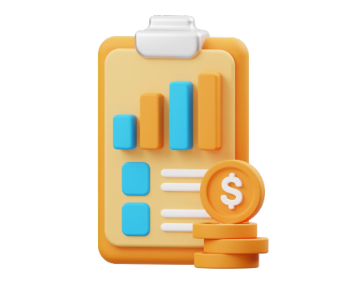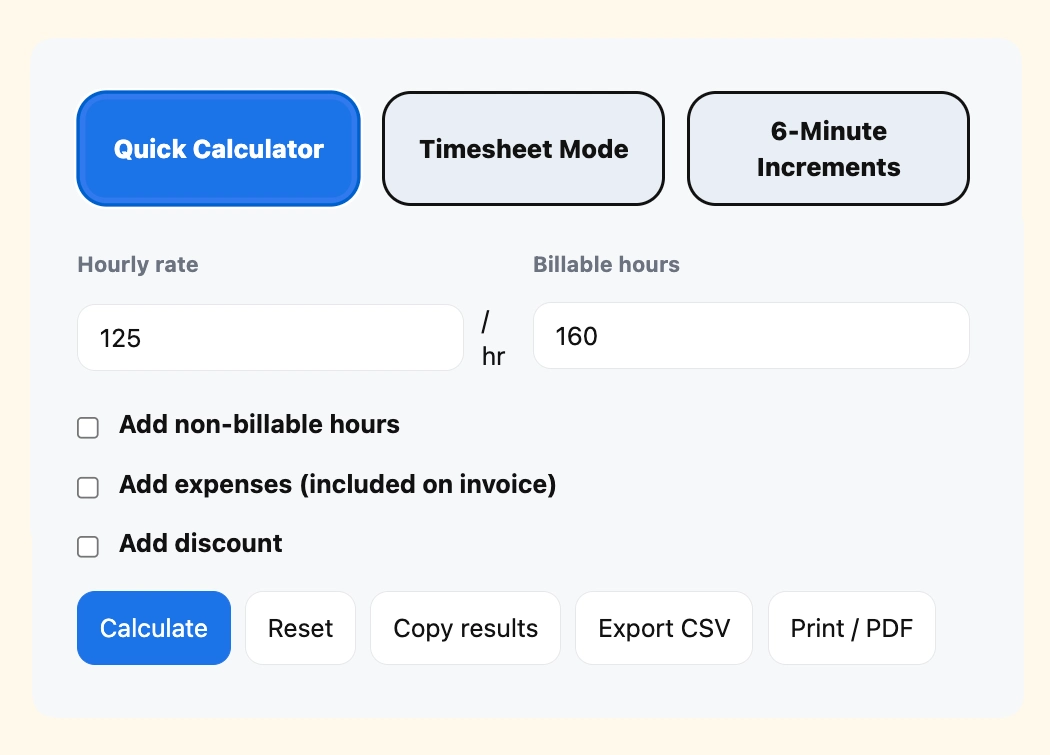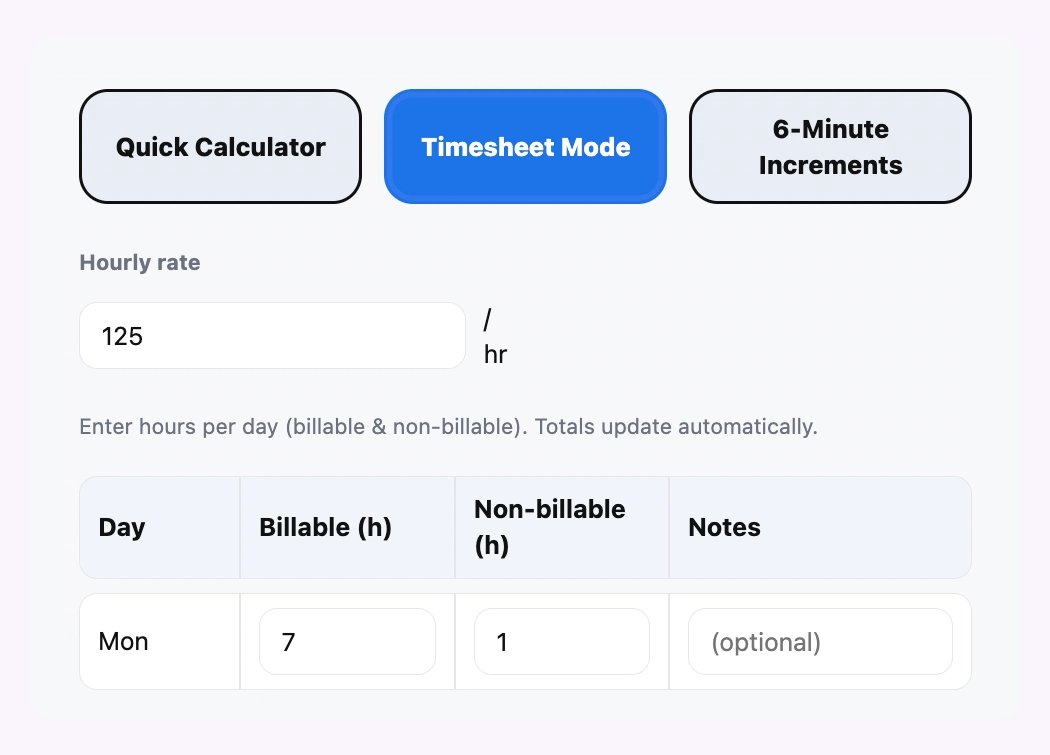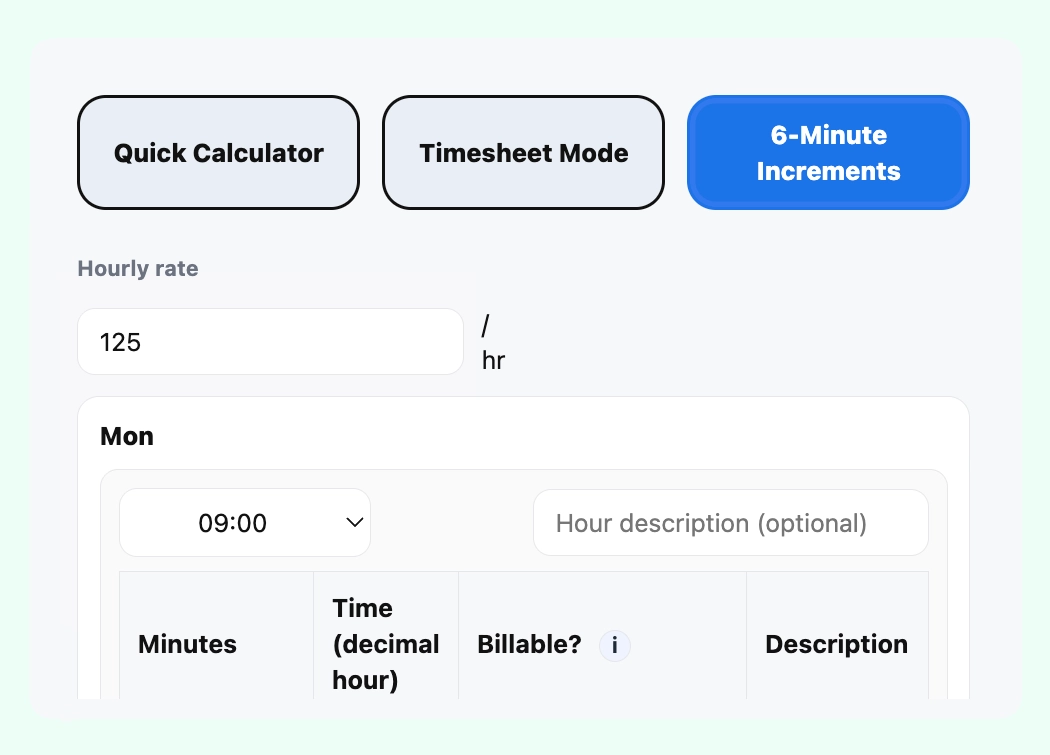What does it measure?
Before we explain how the billable hours calculator works, here’s what you need to know about what it measures in real time as you input your values.
➡️ Total hours – all the time entries you’ve added to the calculation, summarized (e.g. 20.00h).
Total hours may seem straightforward but the calculator gives you the sum total of all the hours for all the days you’ve put in. This is especially handy in the Timesheet Mode and the 6-Minute Increments mode when you’re adding many time entries over the course of a day or week and want to see your total accumulated hours.
➡️ Total billable revenue – the money that can be invoiced for all the billable hours logged, minus any discounts and plus any expenses you’ve logged.
Formula = Billable hours x Rate – Discount + Expenses
Total billable revenue is the money you can invoice after applying discounts and adding expenses you’ve logged. It’s calculated by multiplying the number of billable hours by your hourly rate, then subtracting discounts and adding expenses if applicable.
➡️ Billable efficiency – the share of time you dedicated to billable work.
Formula = Billable hours ÷ (Billable + Non-billable hours)
Billable efficiency, sometimes referred to as
billable utilization, is a measure of how much of the time was spent on billable work against the total time logged. This helps you understand how productive and efficient you were at revenue-generating activities.
➡️ Effective hourly rate – the actual money you’ve made per hour based on the time you’ve put in and how much of it was billable.
Formula = Revenue ÷ (Billable + Non-billable hours)
Finally, your effective hourly rate is how much you’ve made per hour based on the actual number of hours you’ve logged, including any non-billable time. By comparing your quoted vs effective hourly rate, you can analyze your pricing strategy and determine whether you’re charging enough for your services.
How to calculate billable hours
To calculate your billable hours for a period of time, you need to know your numbers and apply a basic formula – or use an online calculator such as this one. To illustrate how our billable hours calculator works to give you not only your total billable revenue but also metrics such as billable efficiency and effective hourly rate, let’s look at some example calculations.
💡 Example 1: You’re a freelancer who worked 20 hours on a client project, and your hourly rate is $40.
To calculate your total billable revenue for the project, we need to multiply your hourly rate of $40 by the number of 20 hours worked – and we get $800 in revenue.
If all of the time spent on that project is billable, your billable efficiency is at 100%. Your effective hourly rate is the same as your quoted rate – $40.
If, say, 5 hours out of the 20 hours worked were non-billable, then your billable efficiency drops to 80% and your effective hourly rate becomes $32/hr.
Memtime automatically tracks both billable and non-billable time for you – so you always know what to put on the invoice.
Try for free
💡 Example 2: You’re a lawyer who worked a total of 9 hours in a day, 6.3h out of which was billable client work; your hourly rate is $200.
To calculate your total billable revenue for the day, we need to multiply your hourly rate of $200 by the number of 6.3 hours you can bill to clients – that’s $1,260.
However, seeing how you worked a total of 9 hours that day, we need to consider your billable hours vs actual hours. Your billable efficiency is 70%, which makes your effective hourly rate $140.
💡 Example 3: You’re an architect estimating a client project. Your regular hourly rate is $70 but the client wants to hire you full-time for the duration of the project.
You’re unsure what price to quote but estimate that the project will take 3 weeks to complete.
To calculate your total billable revenue, we need to multiply your hourly rate of $70 by the number of 120 work hours for the 3 weeks – and we get $8,400. However, you want to add a discount of 15% as a token of goodwill, which makes your total billable revenue $7,140.
Your effective hourly rate becomes $59.50 against the original $70, which you can put on the invoice to showcase the discount.
Can you trust the results?

The math behind billable hours calculations is clear – as long as you know your hourly rate and the total hours worked, you’ll get reliable revenue and productivity metrics.
The question is, do you know your billable hours? Even better, do you know your non-billable hours?
Most people hate tracking time, and for a good reason. It’s distracting, unrewarding, and requires manual work such as setting the timer and jotting down task descriptions. The result is that 33-64% is forgotten or misattributed, i.e. logged under the wrong project or client.
Now, imagine calculating your billable efficiency with half-accurate billable hours and completely forgotten non-billable hours. At best, you’re left with useless, if not harmful, data. If you’re billing in tenths of an hour, the task becomes truly insurmountable.
No legal billing calculator will give you a reliable estimate if you’re not diligent about tracking every small email and call. It’s true for any industry and professional: an online billable hours calculator is not a replacement for good time tracking tools and habits.
At Memtime, we’ve been talking to service businesses for a decade – these are the people who need to track their hours to make a living. And yet, most of them start off with manual time tracking tools and policies no team of professionals can stick to for a long time.
That’s why we came up with a way to automatically track all computer activity without setting timers or even thinking about tracking time. Our desktop app runs silently in the background and records every minute of every day, with program names, browser windows, and exact URLs. This activity log is offline on your computer and visible only to you.
Memtime can even display your day in 6-minute increments, which is especially useful for attorneys, consultants, and accountants billing in tenths of an hour. You can easily remember any day in the past and calculate your billable revenue, efficiency, and utilization with precision 100% of the time.
It doesn’t cost anything to try Memtime with all features for 14 days. We won’t auto-charge you after your free trial is over.
Why calculate billable hours
Beyond knowing what to put on the invoice as a service provider, why calculate billable hours? Let’s see some use cases of a billable hours calculator such as this one.
Analyze your hourly rate

Our calculator helps you take a critical look at your hourly rate and decide whether it’s justified in the light of how much time you actually invest in each project. The longer you use the calculator, the more effective hourly rates you can analyze.
If you see a pattern of overservicing and
undercharging clients for the work done, you may consider increasing your hourly rate.
Measure utilization
As a salaried worker, you may want to calculate your billable hours too – if only for the sake of knowing your billable utilization. It’s a measure of how productive you are and how much revenue-generating work you do for your employer.
When you know your billable efficiency over a period of time, you can use it in negotiating a salary increase or a promotion. Any manager looking to optimize their team’s time is interested in growing billable utilization so you can speak their language of numbers to make your argument more persuasive.
Estimate pricing
If you’re embarking on a project with a different pricing structure to the hourly rate you normally use, a calculator helps you precisely estimate and consider different scenarios (timelines, discounts, etc.)
You can quote the final price even broken down into exact hours you’re planning to put into the work each day of the week. Tweak the input and the calculations update in real time, allowing you to adjust the variables for each scenario.
Use as a timesheet
If you don’t use any kind of time tracking or project management software that comes with a timesheet – or any
free timesheet template – you can use a billable hours calculator to note your hours day to day in as much detail as you need.
In the Timesheet Mode, you can input daily totals and export as CSV. In the 6-Minute Increments mode, you can track multiple small tasks on days when you work on many client projects or cases. The calculator even allows you to export data for printing, which eliminates the need for a standalone timesheet.






